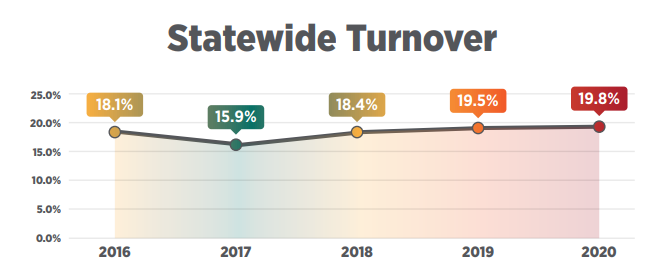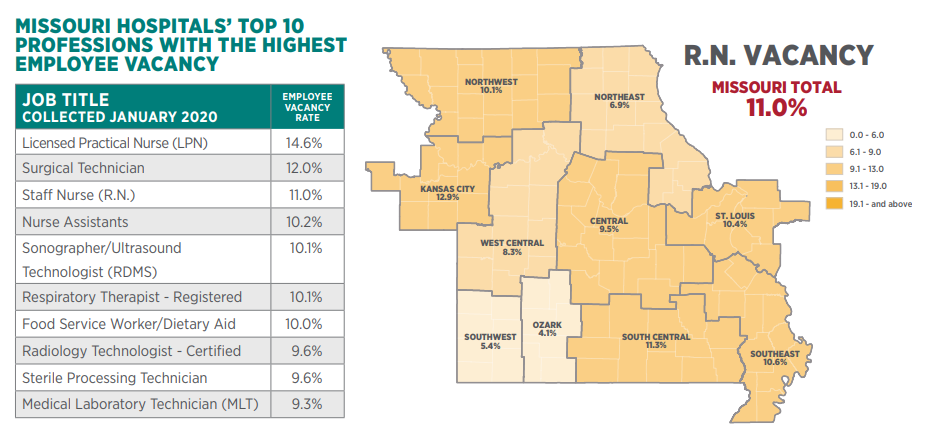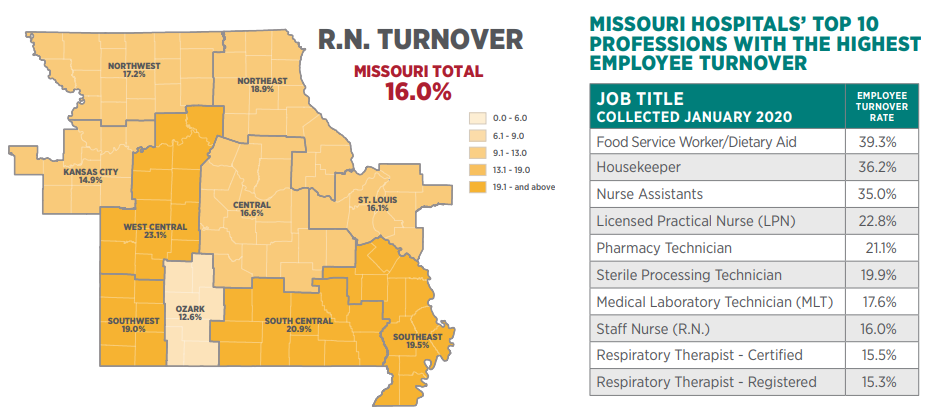Expert

Jill Williams
Actions
Type
Topic
- Economic Impact
- Workforce
Tags
Since 2001, the Missouri Hospital Association has released an annual analysis of the status of the hospital workforce. Hospitals are essential community supporting institutions, and maintaining the workforce is necessary to the health of all Missourians. The report is designed to assess the current state of employment, project future needs, and identify promising strategies and opportunities for stakeholder collaboration to maintain hospitals’ ability to serve.
The data represented in this report reflect the status of the hospital workforce in 2019. As a result, the report reflects a pre-COVID-19 workforce.
Data reported in 2019 validate the need to address critical health professional shortages in nursing and allied health occupations. The report finds increased vacancy rates among a majority of the health care positions surveyed. In addition, the data indicate that while turnover has decreased for several positions, combined turnover among all professionals surveyed reached an all-time high at 19.8% statewide.

It is impossible to anticipate how disruptive the COVID-19 pandemic will be to the hospital workforce. Despite the public health emergency, many caregivers — those who support the front line and hospital staff in general — have been sidelined as hospital services were reduced through policy or as a natural extension of social distancing. Hospitals have implemented various strategies to maintain the current workforce, however reduced hours, furloughs and layoffs have occurred. Many of these employees will return as patient volume increases, while others remain in the training pipeline facing uncertainty. Some may not return to work at the hospital indefinitely.
In addition to illustrating the workforce challenges as they existed pre-COVID-19, this report outlines strategies hospitals can use to address the complex and interconnected problems presented for hospitals during COVID-19. The unprecedented stress placed on hospital staff during the COVID-19 pandemic will require better internal communication, increased flexibility by leadership, and could lead to organizational cultural change. Employee anxiety over work schedule fluctuations, and COVID-19-related changes to care, must increase leaders’ sensitivity to behavioral health within the workforce.
Demand for hospital and health care services remains strong. The short-term workforce challenges presented by COVID-19 will abate. However, the lessons learned about its influence on hospital organizations will shape thinking about staffing opportunities and vulnerabilities well into the future.
VIEW THE FULL WORKFORCE REPORT
The report includes data from 138 hospitals and identifies trends among 28 hospital-based positions and four clinic and physician practice positions.
2020 Regional Reports
- Central
- Kansas City
- Northeast
- Northwest
- Ozark
- South Central
- Southeast
- Southwest
- St. Louis
- West Central
Also available is a workforce report specific to Missouri’s critical access hospitals. Missouri is home to 35 CAHs, and each submitted CY 2019 data for MHA’s 20th annual workforce survey that focuses on turnover and vacancy rates both regionally and statewide.


COMMUNICATE EARLY AND OFTEN
Employees need communication early and often, with the information necessary to do their jobs, so they can respond to change with resilience. Employees first look to their employers for critical information about COVID-19 and view their organizational leaders as a trusted source for that information.
Leaders also need to show they have a plan and be transparent about what is driving decisions. Employees need to have confidence in their leaders’ capability to navigate the future, and a leadership team that responds proactively versus reactively provides reassurance to staff in volatile times.
LEAD WITH FLEXIBILITY AND UNDERSTANDING
Flexibility and understanding have been key in this new environment. The COVID-19 pandemic has forced many hospital employees to work from home. This shift to remote work is prompting leaders and employees to adjust to new ways of working. Not only will employees expect more flexibility, but the nature of work itself will change. For many, remote and virtual work is becoming the new normal, and measuring engagement and collaboration among managers and remote employees have come to the forefront of the workplace.
As employees manage disrupted child care and elder care, difficulties securing essential supplies at home and potential health care issues, the need for work-life balance is greater than ever. Right now, whether at home or on the front lines of care, teams need flexibility and permission to work differently. Managers must remove barriers and advocate for more flexibility to empower their teams to adapt, while keeping patient care at the focus.
RETHINK WORKFORCE PLANNING
Hiring for essential positions must continue. Many hospitals have had to rapidly adapt regular recruiting efforts – changing how they recruit, hire and train new employees – to keep candidate pipelines full in this new work landscape. Talent acquisition teams have been challenged with staying connected with the candidates through the entire interview process by text, telephone and video calls instead of face-to-face meetings. Onboarding new hires may take place in a rapid manner, if not virtually, and while trying to create a sense of welcome, community and inclusion.
Hospitals have had to rethink staffing and reconfigure roles. This talent fluidity has been shown in hospitals through centralized staffing plans, team care, job reassignment and labor pools, as well as by identifying retired staff and staff within the facility who could provide support in critical areas. These plans focus on reskilling workers to ensure “critical roles” would be maintained.

When COVID-19 arrived in Missouri, hospitals activated their emergency response plans and stepped up to the plate. However, this event also has shown the importance of hospitals having a backup plan for staff in critical positions below the C-suite. What happens if the virus affects someone at an organization who is in a position below the senior ranks, perhaps the payroll or benefits and compensation manager? Succession planning for staff in key roles is important to prevent further disruptions within an organization.
With hospital budgets being strained and hospital staffing being approximately half the cost of operations, some have implemented alternatives to layoffs, such as hiring freezes, furloughs, flexible working arrangements, and reductions in salary and benefits. Hospitals have explored a variety of ways to reduce workforce spending while helping employees get the most of unemployment compensation, and health and retirement benefits. Employee retention should be a top priority for hospitals during challenging times. When a temporary layoff is unavoidable, hospitals should communicate the desire to retain its workforce.
PRIORITIZE EMPLOYEE WELL-BEING
Assisting workers with their well-being has never been more important. This focus is especially important as workers experience anxiety in dealing with COVID-19. Providing access to mental health support for staff feeling overwhelmed or concerned has been on the rise amidst the pandemic. Employers currently are focused on doing whatever it takes to help employees make it through the outbreak as unscathed as possible, and this trend will continue to take place in the future.
Protecting employees from exposure in the workplace and providing a working environment where employees feel safe and have the proper personal protective equipment have been top priorities. Employees need help feeling empowered to keep themselves and their families safe and well. Asking early and often what staff need or are concerned about will help hospital leadership teams determine best actions.
Hospitals provided staff with resources for their families, such as increasing the capacity of their child care centers, forming employee babysitting pools, and working with local organizations such as the YMCA to assist with child care needs. Some hospitals have gone as far as to subsidize child care for their employees during this time.

EMPHASIZE ORGANIZATIONAL CULTURE
Many people work in the health care field because they share values and a sense of a larger purpose. In times of crisis, shared values and purpose need to shine through brighter than ever, as this is the basis for people’s sense of connection, of belonging to something larger than themselves.
As hospitals emphasize concern not just for their own people, but also for the community, workers are provided a connection to something larger than the instability they’re experiencing. During this time, employees need hospital leadership to be focused on compassion and the care of employees and patients, as well as their community.
Culture always matters, but it is especially important now. Decisions made now will have important consequences in the longer term. Reconnecting with purpose and values will help organizations look back with pride at how they responded. This is a time where hospitals can lead employees with grace, courage and resilience.
WORK COLLABORATIVELY
Communication, teamwork, innovation, problem solving and moving forward as a team have been more critical in this moment than ever. Hospitals have rapidly come together to remove silos, work collaboratively and recognize that everybody’s on the same team. Hospitals also have been forming new relationships with other health care organizations, sharing resources and best practices with colleagues and peers.
Collaboration and partnerships have been even more crucial in today’s rapidly changing environment. Hospitals have been working collaboratively with local government, state departments, schools, businesses, nonprofit organizations and other community partners. Integrating stakeholders from organizations and communities has played an important role in slowing the spread of disease and providing hospitals with the data, tools, resources and PPE they need to care for their employees and communities. This collaboration will reinforce important long-term relationships among partners.
These partners, along with individuals in the community, have stepped up to support health care workers and show their support by writing to Congress, participating in social media, donating supplies, delivering food and more.
METHODOLOGY
A total of 138 Missouri hospitals participated in this year’s survey. The survey requested data on 28 hospital health care positions and four clinic and physician practice positions. Responses are collected by Missouri Hospital Association. Data are reported as of Dec. 31, 2019.











